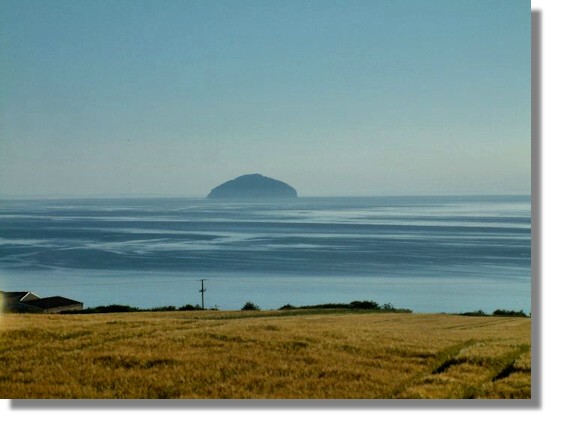

Lighthouse Beacons from Scotland
Ailsa Craig

Ailsa Craig from Mainland Ayrshire
Ailsa Craig is an island in the Firth of Clyde, just offshore from Girvan, South Ayrshire. It is known as "Paddy's Mile Stone" as it lies halfway between the cities of Glasgow and Belfast. Geologically, the distinctively shaped island rises to 1,110 feet above sea level was formed through volcanic activity and has large quantities of granite. This was mined and shipped back to the mainland where it was shaped and polished into curling stones. Mining began in the early 19th century and ended in the early 1970s. As well as being a local landmark with its conical summit it is a well known marine navigational hazard. The island is a protected bird sanctuary, sheltering thousands of breeding pairs of sea birds. Other wild life found on and around the island are grey seals, the occasional whale, and large basking sharks during the summer months feeding on planktonic bloom. Landing on the island is by permit only, obtainable from the local authorities. (Graphic on the right of Ailsa Craig is by Richard Webb, via Wikimedia).
In 1881, petitions were submitted by Lloyds and the Scottish Shipmasters Association requesting the erection of two fog signals, at the north and south ends of the island and a lighthouse on Ailsa Craig. Work commenced the following year and the light was first exhibited on the night of 15 June 1886, an oil burning light which remained in use until 1911, when it was converted to incandescent. The construction was supervised by Thomas and David Stevenson, Engineers to the Board. (Thomas was the father of Robert Louis Stevenson). Fog signals were discontinued in 1987. Then, in 1990, the lighthouse was automated, and a refurbishment took place in 2001, when it was converted to run on solar power. (Graphic on the left is by James T. M. Towill via Wikimedia)
Until radio communications were established on Ailsa Craig in 1935, the lightkeepers and employees of Ailsa Craig Granites Ltd used to depend on pigeons for communications. A pigeon house was established at Girvan Green, where the town council established a parking place for cars and buses in 1935. When a doctor or supplies were required urgently in stormy weather when it was impossible to have messages taken by carrier pigeon, a system of signals by fire was used, the number of fires and their location sending different messages.
Return to Index of Lighthouse Beacons from Scotland



